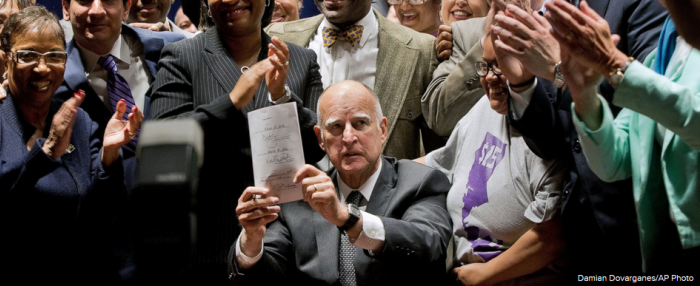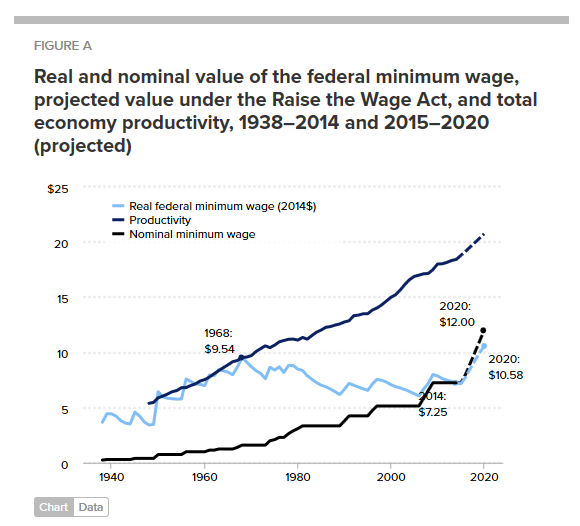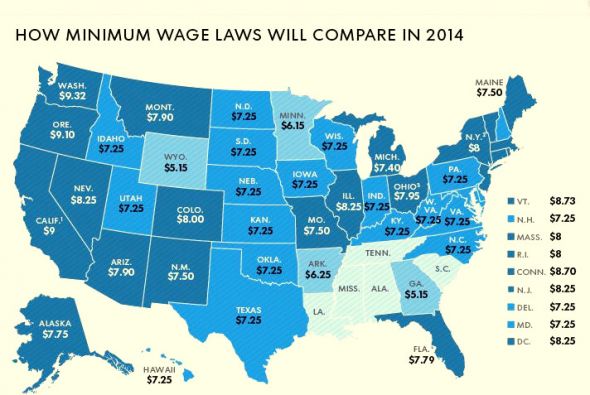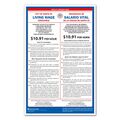Category:Minimum Wage
<addthis />
Minimum Wage History in United States
- ··················································································································
- "Living Wage" - http://www.greenpolicy360.net/w/Living_wage,_Living_income
- ··················································································································
Raising the Minimum Wage to $12 by 2020 Would Lift Wages for 35 Million American Workers
Economic Policy Institute Report • July 2015
- Real wage growth ended with the start of the Reagan administration while productivity [and corporate profits] continued to soar
Key Minimum Wage Issues and Findings
The minimum wage was established in 1938 as part of the Fair Labor Standards Act (FLSA). In addition to prohibiting child labor and mandating the 40-hour workweek, the FLSA established the federal minimum wage to help ensure that all work would be fairly rewarded and that regular employment would provide a decent quality of life. Moreover, regular increases in the minimum wage were meant to ensure that even the lowest-paid workers benefited from broader improvements in wages and living standards.
Yet today, because of decades of infrequent and inadequate adjustment, the federal minimum wage no longer serves as an adequate wage floor. Every year that the minimum wage is left unchanged, rising prices slowly erode its buying power. In 2014, the federal minimum wage of $7.25 was worth nearly 10 percent less than when it was last raised in 2009, after adjusting for inflation. In fact, the real (inflation-adjusted) value of the federal minimum wage in 2014 was 24 percent below its peak value in 1968.
SUPPLEMENTARY DATA: State-by-state characteristics of workers who would be affected by increasing the federal minimum wage to $12 by 2020 [PDF]
This decline in purchasing power means low-wage workers have to work longer hours just to achieve the standard of living that was considered the bare minimum almost half a century ago. Over that time, the United States has achieved tremendous improvements in labor productivity that could have allowed workers at all pay levels to enjoy a significantly improved quality of life. Instead, because of policymakers’ failure to preserve this basic labor standard, a parent earning the minimum wage today does not earn enough through full-time work to be above the federal poverty line.
In April 2015, Sen. Patty Murray (D-Wash.) and Rep. Robert “Bobby” Scott (D-Va.) introduced the Raise the Wage Act of 2015, a bill that would raise the federal minimum wage in five steps to $12 per hour by 2020. Beginning in 2021, the minimum wage would be “indexed” to median wages so that each year, the minimum wage would automatically be adjusted based upon growth in the median wage. The bill would also gradually increase the subminimum wage for tipped workers (or “tipped minimum wage”), which has been fixed at $2.13 per hour since 1991, until it reaches parity with the regular minimum wage.
This report begins by providing historical context for the current value of the federal minimum wage and the proposed increase to $12 by 2020. It then describes the population of workers likely to receive higher pay under an increase to $12 by 2020, with detailed demographic data that refute a number of common misconceptions about low-wage workers. The report concludes with a discussion of the provisions of the Raise the Wage Act that would index the minimum wage to median wages, and gradually eliminate the subminimum wage for tipped workers.
Key findings include:
*A $12 minimum wage in 2020 would undo the erosion in value of the minimum wage that took place largely in the 1980s. It would also reverse the growth in wage inequality between low- and middle-wage workers over the past generation.
- Raising the minimum wage to $12 by 2020 would directly or indirectly lift wages for 35.1 million workers—more than one in four U.S. workers.
- Over the phase-in period of the increases, affected workers would receive nearly $80 billion in increased wages. Once the increase is fully phased-in, the average affected worker would earn roughly $2,300 more each year than she does today (assuming no change in the number of work hours).
- The workers who would receive a pay increase do not fit the stereotypes of low-wage workers.
- The average age of affected workers is 36 years old. A larger share of affected workers are age 55 and older (15.3 percent) than are teens (10.7 percent). About two-thirds of affected workers are 25 years old or older.
- The majority of affected workers (55.9 percent) are women.
- Workers of color would disproportionately be affected, with more than one-third of black and Hispanic workers receiving a raise.
- Of workers who would receive a raise, the majority (57.4 percent) work full time, nearly half (45.1 percent) have at least some college experience, and more than a quarter (27.7 percent) have children.
- More than one-third (36.5 percent) of single parents who work would receive higher pay, including nearly 40 percent of working single mothers.
- The workers who would benefit are, on average, the primary breadwinners for their family, earning more than half (54.3 percent) of their family’s total income.
- Indexing the minimum wage to median wages would ensure that low-wage workers share in broad improvements in U.S. living standards, and would prevent future growth in inequality between low- and middle-wage workers.
The minimum wage in context:
Since its inception in 1938, the federal minimum wage has been adjusted through legislated increases nine times—from a nominal (non-inflation-adjusted) value of 25 cents per hour in 1938 to the current $7.25, where it has remained since 2009. These increases have been fairly irregular, varying in size and with differing lengths of time between increases. Yet aside from a few very brief deflationary periods in the postwar era, prices have consistently risen year after year. Each year that the minimum wage remains unchanged, its purchasing power slowly erodes until policymakers enact an increase. This haphazard maintenance of the wage floor has meant that low-wage workers of different generations or in different decades have been protected by significantly different wage standards.
Read the Full Report for More Data and Recommendations
Additional References
- ··············································································································································
- Minimum Wages by Country - https://en.wikipedia.org/wiki/List_of_minimum_wages_by_country
- ··············································································································································
- http://www.cato.org/blog/raise-wage-act-more-rhetoric-reality [In Opposition]
··························································································
Prognosis: 0% chance of being enacted (details)
https://www.govtrack.us/congress/bills/114/s1150
·
Pages in category "Minimum Wage"
The following 20 pages are in this category, out of 20 total.
Media in category "Minimum Wage"
The following 13 files are in this category, out of 13 total.
- California at the forefront of US environmental policies.png 600 × 450; 50 KB
- Economic-justice for women.jpg 600 × 600; 29 KB
- EleanorRooseveltHumanRights.png 535 × 423; 60 KB
- Equal Pay for Equal Work Women Employed.png 450 × 312; 52 KB
- Global Climate Action Summit.png 640 × 400; 470 KB
- Governor Jerry Brown signs Fair Wage Act April 2016.png 700 × 286; 477 KB
- Living Wage campaign.jpeg 235 × 235; 11 KB
- MinWageLaws 2014.jpg 590 × 395; 47 KB
- Sacramento - state capitol assembly.jpg 640 × 422; 101 KB
- Santa Fe Living Wage poster.jpg 800 × 800; 150 KB
- Time for a raise -SOTU2015.jpg 640 × 377; 0 bytes
- Womens-day.jpg 640 × 334; 55 KB














